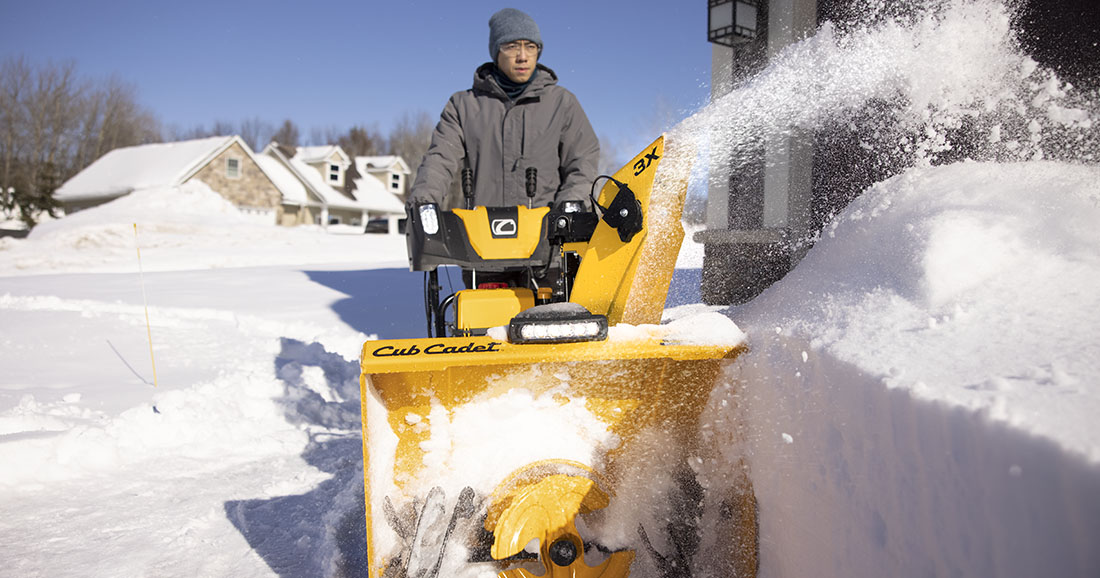How to Prepare Your Snow Blower for Storage in the Off-Season

As winter’s worst comes to an end, it’s time to put your faithful snow blower away for the offseason. These instructions will explain how to prepare your snow blower for offseason storage. Proper storage is essential to make sure your unit continues to perform at an optimal level. Some steps differ depending on your model type, so always make sure to refer to your operator’s manual for comprehensive instructions on maintenance and storage.
Prepare For Maintenance
Place your snow blower on a flat surface. Turn the engine off and let it cool. Disconnect the spark plug ignition wire and remove the safety ignition key to prevent accidental starting of the engine.
Single-Stage Units
Carefully tilt the snow blower back so it rests on the handle. This will allow you to easily access various components. Once done, check the shave plate. This can wear out over time and will need to be replaced when it does. The shave plate on your snow blower has two wearing edges, simply reverse it to maximize the life of the plate. If it's already been reversed, replace it with genuine, original equipment part from Cub Cadet.
The auger’s rubber paddles become worn with use. They should be replaced if any excessive wear is present. Once done, remove the belt cover on the side of the snow blower and check the belt for signs of wear, cracks, or fraying. Replace if necessary.
Two- And Three-Stage Units
The shave plate and skid shoes protect the housing from damage. Check both for damage and wear. If present, replace these items with genuine, original equipment parts from Cub Cadet.
Drain any fuel left in the tank using the siphon pump. A siphon pump can be purchased on cubcadet.com. With the help of another person, carefully pivot the snow blower up and forward so it rests on the auger housing. This will allow you to easily access the parts of the snow blower that require maintenance.
Remove the lower frame cover from the underside of the unit. Apply a light coating of oil to the hex shaft. Be careful not to get any oil on the aluminum drive plate or the rubber friction disc. Check the rubber friction disc for wear or cracking.
Before checking the snow blower belt, put the lower frame cover back in place. With the help of an additional person, carefully pivot the snow blower back and down so it rests on the wheels and skid shoes.
Remove the belt cover on the front of the engine and inspect the belts for wear, cracks and fraying. If the belts are worn, they should be replaced immediately. Worn belts can break when you least expect it so make sure you replace your snow blower belt as soon as you see signs of wear. Put the plastic belt cover back in place or order a new one if needed.
All Units
Drain and refill the engine oil before storing your snow blower. Refer to your engine's Operator's Manual for the correct viscosity and oil capacity. Always dispose of the used oil in an environmentally responsible manner.
Remove the spark plug and inspect it for signs of corrosion or residue build-up. Clean it with a wire brush if necessary. If you are unsure if the spark plug is good or not, it is recommended that you replace the spark plug. Reinstall the spark plug and reconnect the spark plug ignition wire.
Clean debris from around the engine and muffler. Apply a light film of oil on any areas that are susceptible to rust. Wipe away any dried salt that may have accumulated to help prevent your unit from rusting over the winter.
Finally, fill your engine's fuel tank with fresh gasoline and add a fuel stabilizer. Be sure to run the engine for five minutes so that the stabilized fuel is circulated through to the carburetor. This is better than storing it empty because an empty fuel system exposes any bare metal parts within it to air and moisture - which can lead to rust and allows gaskets and O-rings to dry out, crack and shrink, causing eventual leaks. It also is good practice to use a cover over your equipment during the offseason to protect it from dirt, dust and rodents that might find it to be a good nesting spot. If you plan to cover the snow blower, make sure air can get under the cover.
Prepare For Next Winter
If any of the items mentioned above need replacing at the end of the season, it's a good time to order and install them before you put your snow blower into storage. You can order parts for your unit using our product finder.
Following these steps for proper snow blower storage will help ensure you have a well-functioning machine the next winter. Remember to complete each of the steps outlined above, skipping a snow blower storage maintenance procedure can result in expensive repairs down the road. For more snow blower maintenance tips, check out our Cub Cadet how-to articles.
